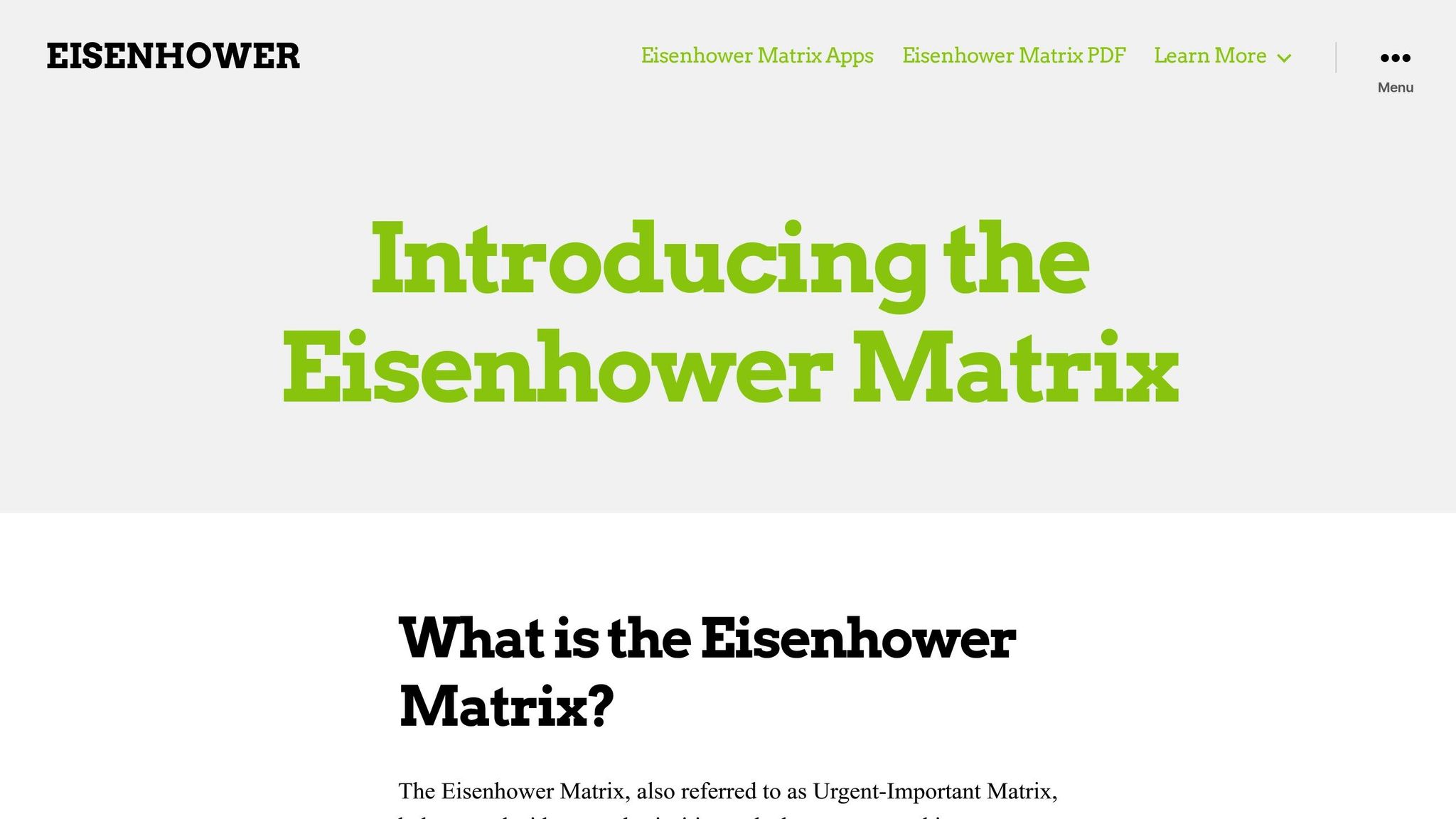How to Prioritize Tasks When Everything Feels Urgent
Learn effective strategies to prioritize tasks and manage your workload when everything feels urgent, ensuring productivity and focus.

When everything feels urgent, it’s easy to get overwhelmed. The key to staying productive is learning how to prioritize effectively. Here’s a quick breakdown of how to manage your tasks:
- Understand the Difference: Urgent tasks demand immediate action (e.g., deadlines, crises), while important tasks contribute to long-term goals (e.g., planning, skill-building).
- Use Proven Methods:
- Eisenhower Matrix: Categorize tasks into four quadrants (Do, Schedule, Delegate, Eliminate).
- ABCDE Method: Rank tasks by priority (A = must do, E = eliminate).
- Ivy Lee System: Focus on the top 6 tasks daily, in order of priority.
- MoSCoW Method: Classify tasks as Must-have, Should-have, Could-have, Won’t-have.
- Leverage Tools: Use task management apps with features like priority flags, due dates, and AI-powered insights.
- Time Blocking: Schedule high-priority tasks during peak productivity hours and include buffer zones for flexibility.
- Daily Reviews: Spend 15 minutes each morning reassessing priorities to stay on track.
The Eisenhower Matrix: How to Prioritize and Master Productivity

Urgent vs. Important: Key Differences
Knowing the difference between urgent and important tasks is essential for prioritizing effectively. Urgent tasks need immediate attention, while important tasks focus on achieving your long-term goals. Understanding this distinction is the first step toward organizing your workload efficiently.
Defining Urgent and Important Tasks
Urgent tasks are time-sensitive and must be addressed right away to avoid immediate consequences. Examples include:
- A client issue that requires a quick resolution
- An unexpected system failure disrupting operations
- Last-minute meeting requests from leadership
- Approaching deadlines for critical deliverables
On the other hand, important tasks may not demand immediate action but play a key role in your long-term success. Examples include:
- Setting strategic goals
- Investing in professional growth
- Building meaningful relationships
- Allocating resources for upcoming projects
| Task Type | Characteristics | Examples | Impact |
|---|---|---|---|
| Urgent | Time-sensitive, immediate action | Crisis management, outages | Short-term, reactive |
| Important | Goal-focused, long-term impact | Strategic planning, learning | Long-term, proactive |
The Eisenhower Matrix Explained
The Eisenhower Matrix is a practical tool for organizing tasks by urgency and importance. It divides tasks into four quadrants, making prioritization clearer.
Here’s how to approach each quadrant:
1. Urgent and Important (Do First)
These tasks are both critical and time-sensitive. They should be tackled immediately and personally.
- Managing crises
- Meeting pressing deadlines
- Resolving critical business issues
2. Important but Not Urgent (Schedule)
These tasks contribute to long-term goals but don’t require immediate action. Schedule time for them in your calendar.
- Strategic goal-setting
- Professional skill-building
- Strengthening key relationships
- Preventive maintenance
3. Urgent but Not Important (Delegate)
These tasks need quick attention but can be handled by others. Delegate them to trusted team members.
- Routine admin work
- Basic email replies or calls
- Minor tech support
4. Neither Urgent nor Important (Eliminate)
These tasks don’t add value or require immediate focus. Cut them out or minimize the time spent on them.
- Scrolling through social media
- Unnecessary meetings
- Low-priority admin tasks
3 Methods to Sort Your Tasks
Here are three practical ways to organize your tasks and stay on top of your priorities.
ABCDE Priority Ranking
The ABCDE method helps you assign priority levels to tasks based on their impact. Each letter represents a different level:
- A - Must Do: Tasks that are critical. Failing to complete these will have serious consequences and directly affect your key goals.
- B - Should Do: Important tasks with lesser consequences. These matter but don't carry the same urgency as A-tasks.
- C - Nice to Do: Tasks with no immediate impact. While they may help in the long run, they aren't essential right now.
- D - Delegate: Tasks that others can handle. Assign these to team members or automate them where possible.
- E - Eliminate: Tasks that don't add value. Remove these from your list entirely.
Start by listing all your tasks, then assign each one a letter. Always tackle A-tasks first before moving on to B-tasks, and so on. Once you've got this down, you can simplify your daily focus using the Ivy Lee system.
The Ivy Lee 6-Task System
This system, introduced by productivity expert Ivy Lee in 1918, helps you focus on your six most important tasks each day. Here’s how it works:
1. Plan Ahead
At the end of your day, write down six specific tasks you aim to complete tomorrow. Make sure each one is clear and realistic.
2. Rank by Priority
Arrange these six tasks by importance. The most critical task goes first, followed by the next most important, and so on.
3. Work in Order
The next day, focus on the first task until it’s done. Only then move to the second task. Any unfinished tasks roll over to the next day’s list, where they become top priorities.
If you need a project-level approach, consider the MoSCoW method.
MoSCoW Task Sorting
The MoSCoW method categorizes tasks based on their importance and urgency:
| Category | Description | Example Tasks |
|---|---|---|
| Must-have | Essential tasks crucial for success | Client deliverables, compliance, bug fixes |
| Should-have | Important but not critical | Process improvements, feature updates |
| Could-have | Optional tasks that are nice to complete | Non-essential features, minor upgrades |
| Won’t-have | Tasks not relevant for now | Future enhancements, low-priority updates |
Focus your time and energy on Must-have tasks first. Should-have tasks come next, while Could-have tasks are tackled only if resources allow. Won’t-have tasks are set aside to avoid distractions.
Regularly review your task categories to ensure they align with any changes in priorities. This keeps your efforts focused on what truly matters.
Digital Tools for Task Management
Digital tools can make handling tasks easier and more efficient. They help you stay on top of priorities and manage your workload effectively.
Task Apps and Their Key Features
Task management apps come with helpful features to keep your work organized:
- Priority Flags: Use labels or color-coding to highlight urgent tasks.
- Due Date Tracking: Set deadlines and receive reminders to stay on schedule.
- Task Dependencies: Link related tasks to ensure everything flows in the right order.
- Progress Tracking: Keep an eye on task completion and milestones.
- Team Collaboration: Share tasks and updates with colleagues or stakeholders.
For more complex projects, look for apps that support methods like the Eisenhower Matrix or MoSCoW method to prioritize tasks effectively.
Time Blocking with Digital Calendars
Time blocking can help you focus and make better use of your day. Here's how to use it:
-
Schedule Priority Blocks
Reserve your most productive hours for high-priority tasks. -
Create Buffer Zones
Add 15-minute gaps between tasks to handle unexpected interruptions without throwing off your day. -
Set Recurring Blocks
Dedicate regular time slots for specific activities:- Daily planning: Spend about 20 minutes each morning organizing your day.
- Weekly priority reviews: Take 30 minutes every Friday to reassess your priorities.
- Email management: Allocate two 30-minute sessions per day to handle emails.
Digital calendars with AI features can make this process even smoother by offering insights to refine your schedule.
AI Tools for Task Organization
AI-powered tools can take your task management to the next level. Here’s what they can do:
| Feature | Benefit | Application |
|---|---|---|
| Smart Sorting | Groups tasks by urgency automatically | Helps you focus on what's most important |
| Task Analysis | Tracks your completion patterns | Fine-tunes your schedule and time usage |
| Priority Insights | Recommends task order based on past actions | Speeds up decision-making |
| Automated Updates | Adjusts deadlines as progress changes | Keeps your task list up-to-date |
When choosing AI tools, pick ones that integrate well with your current systems. This ensures smoother adoption and consistent use for better task management.
Make Prioritization a Daily Habit
Set aside time each morning to review and organize your tasks. A quick daily review can help you stay on track and adjust your priorities as needed.
Daily Priority Reviews
Dedicate 15 minutes at the start of your day - like 8:45 AM to 9:00 AM - for a focused review. Use this time to:
- Check deadlines and task dependencies to refocus your efforts.
- Adjust priorities based on new information or changes.
Conclusion
Prioritizing tasks helps you stay focused and lowers stress in today’s busy work environment. Using methods like the Eisenhower Matrix or the ABCDE technique can turn an overwhelming to-do list into a clear, actionable plan.
The key is understanding the difference between urgent and non-urgent tasks. This not only helps you manage your workload but also gives you more time to focus on important initiatives. By consistently using these strategies, you’ll gain a better sense of what truly needs your attention.
A quick daily review helps keep your focus on tasks that matter most, giving you better control over your day. This approach makes it easier to avoid feeling overwhelmed and ensures your energy is spent on work that delivers meaningful results instead of reacting to every minor issue.

